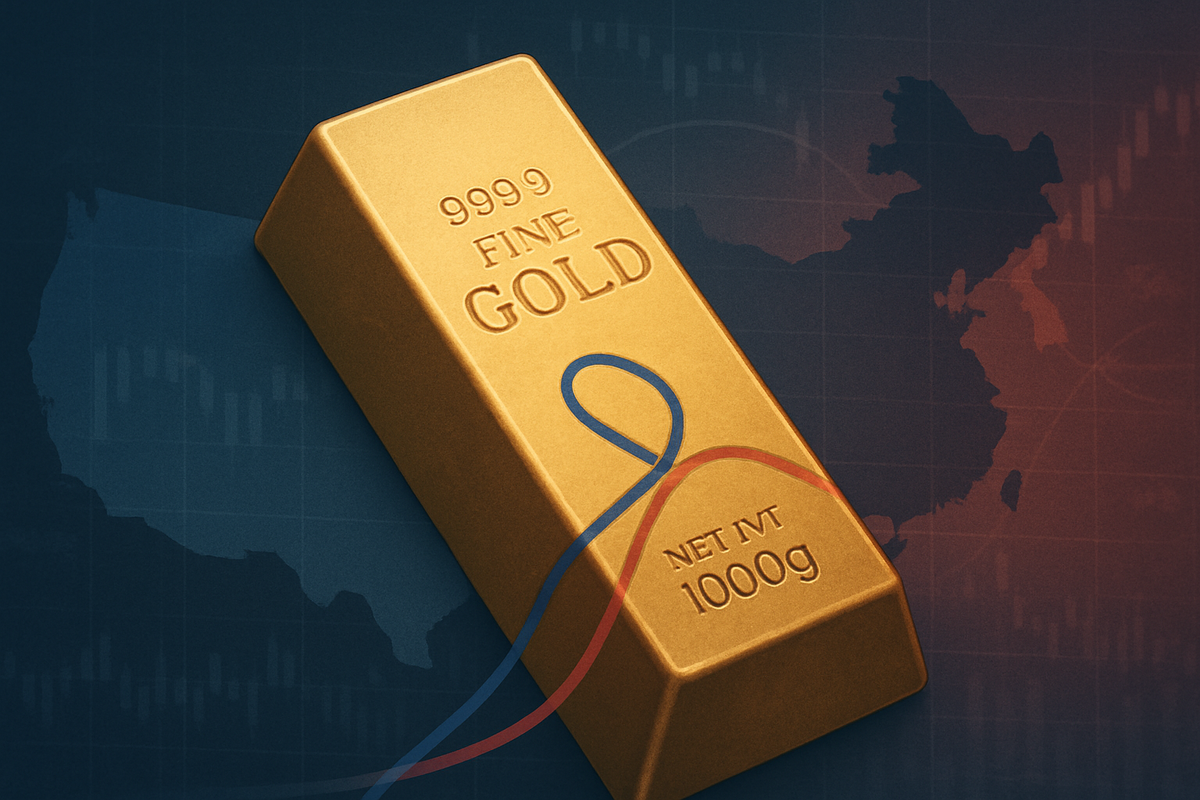
Gold prices, having recently concluded a spectacular record rally throughout 2025, are now navigating a crucial consolidation phase, with every twist and turn in the ongoing US-China trade and geopolitical talks acting as a significant barometer for investor sentiment. After surging by over 60% year-to-date and briefly touching an all-time high of $4,379 per ounce in October 2025, the precious metal has entered a period of recalibration. This consolidation reflects a complex interplay of profit-taking, underlying safe-haven demand, and the immediate impact of diplomatic overtures between the world's two largest economies, leaving market participants keenly watching for definitive signals.
The current stability around the $4,250-$4,260 an ounce mark, following a sharp drop on October 17, 2025, underscores gold's sensitivity to geopolitical headlines. While the broader bullish trend for gold remains intact, largely driven by global uncertainties, central bank accumulation, and dovish monetary policy expectations, the short-term trajectory is heavily influenced by the delicate dance between Washington and Beijing. Investors are seeking clarity on whether recent conciliatory tones will translate into tangible de-escalation or if renewed friction will once again propel the yellow metal to new heights.
The Dance of Diplomacy and the Metal's Mettle
Gold's journey to its record highs in 2025 was propelled by a perfect storm of global anxieties. Escalating geopolitical conflicts in the Middle East and Ukraine, coupled with persistent US-China trade frictions, fueled a robust demand for safe-haven assets. The weakening US Dollar, down over 9% year-to-date due to expectations of a major Federal Reserve rate-cutting cycle that began in September 2025, also made gold more attractive. Furthermore, unprecedented central bank accumulation, particularly from emerging markets diversifying away from the US Dollar, provided a strong structural floor for prices. Concerns over government debt, persistent inflation, and credit issues in the US banking sector amplified a "debasement trade," driving a flight to hard assets.
The consolidation phase, however, began to take shape after gold peaked, with a notable pullback observed on Friday, October 17, 2025. This was largely triggered by comments from US President Donald Trump, who suggested his proposed 100% tariff on Chinese goods was "not sustainable" and expressed optimism about upcoming talks with Chinese President Xi Jinping. These signals of potential de-escalation temporarily eased market jitters, leading to profit-taking. Despite this, the preceding week saw renewed tensions, with President Trump announcing fresh tariffs and export controls, and China expanding its rare earth export restrictions, demonstrating the volatile nature of the relationship.
Key players in this unfolding drama include the US and Chinese governments, their respective central banks, and major financial institutions. US Treasury Secretary Scott Bessent and Chinese Vice Premier He Lifeng are scheduled to meet this week (October 20-24, 2025) in Malaysia to resume trade negotiations, with a potential meeting between Presidents Trump and Xi in South Korea in two weeks. The outcomes of these high-level discussions are paramount, as they directly impact investor confidence and, consequently, gold's appeal as a hedge against uncertainty. Any concrete progress could temper gold's rally, while a breakdown in talks would likely send it soaring again.
Mining for Opportunity: Corporate Winners and Losers
The consolidation in gold prices, while a natural correction after an aggressive rally, presents a nuanced landscape for companies across various sectors. For major gold mining companies, the sustained high price of gold, even during consolidation, generally signifies robust profitability. Companies like Barrick Gold (NYSE: GOLD) and Newmont (NYSE: NEM), two of the world's largest gold producers, have benefited immensely from the elevated prices. While a period of consolidation might temper the meteoric rise in their stock values, the underlying strong gold price environment ensures healthy margins and potentially increased dividend payouts or share buybacks. Their operational efficiency and hedging strategies will determine how well they navigate this phase. Should US-China tensions escalate again, driving gold higher, these miners would see renewed investor interest. Conversely, a significant de-escalation leading to a sustained downturn in gold prices could reduce their profitability and stock valuations.
Beyond the miners, companies involved in gold-backed exchange-traded funds (ETFs) and investment vehicles also stand to gain from the heightened interest in gold as a safe haven. Asset managers offering these products see increased inflows during periods of uncertainty. However, industries that utilize gold as a raw material, such as luxury jewelry manufacturers, electronics companies, and dental material suppliers, face increased input costs. While larger players might absorb these costs or pass them on to consumers, smaller businesses could see their margins squeezed. The stability brought by consolidation might offer some relief from rapidly escalating costs, but the overall high price level remains a challenge. For instance, Tiffany & Co. (NYSE: TIF) or Apple (NASDAQ: AAPL), which uses gold in its circuitry, might experience marginal impacts, but sustained high prices could influence their cost structures and pricing strategies.
The Broader Tapestry: Geopolitics, Policy, and Precedent
Gold's recent performance and current consolidation fit squarely into broader industry trends emphasizing safe-haven assets amidst a fracturing global order. The persistent demand for gold reflects a structural shift where investors and central banks alike are seeking alternatives to traditional fiat currencies, particularly the US Dollar, in an environment of unprecedented government debt, inflationary pressures, and geopolitical instability. This "de-dollarization" trend, visible in increased central bank gold purchases since 2022, is a long-term driver that transcends short-term market fluctuations. The ongoing US-China dialogue is a critical component of this broader geopolitical uncertainty; its resolution or exacerbation has ripple effects across global trade, supply chains, and financial markets.
The regulatory and policy implications of US-China relations are profound. Renewed tariff threats and export controls, as seen recently, can disrupt global supply chains, increase manufacturing costs, and potentially lead to higher consumer prices. This uncertainty prompts manufacturing companies to hedge against input cost volatility, sometimes through precious metals. The outcome of trade talks could dictate the future of global commerce, impacting everything from technology exports to agricultural goods, thereby indirectly influencing the perceived stability of the global economy and, by extension, gold's appeal. Historical precedents, such as gold's rallies during the 2008 financial crisis or periods of heightened Cold War tensions, underscore its role as a crisis hedge. The current scenario, marked by a confluence of economic and geopolitical stressors, echoes these historical patterns, affirming gold's enduring significance as a store of value.
What Lies Ahead: Scenarios and Strategic Pivots
Looking ahead, the short-term trajectory of gold prices will largely hinge on the immediate outcomes of the US-China talks scheduled for this week and in the coming fortnight. A significant breakthrough or a clear path towards de-escalation could lead to further profit-taking and a deeper, albeit likely temporary, consolidation for gold, potentially testing support levels around $4,200 an ounce. Conversely, any failure in negotiations, renewed aggressive rhetoric, or the imposition of new tariffs would almost certainly reignite gold's upward momentum, potentially propelling it back towards or even beyond its recent record highs.
In the long term, the structural bullish case for gold remains robust. Analysts from major banks are already forecasting gold to reach $5,000 per ounce by 2026, driven by sustained central bank demand, persistent global economic uncertainties, and the ongoing de-dollarization trend. Investors and companies may need to consider strategic pivots. For investors, this could mean maintaining a strategic allocation to gold as a portfolio hedge, recognizing its role in diversifying against geopolitical and economic risks. Gold mining companies might focus on optimizing operational costs and exploring new reserves to capitalize on sustained high prices. Market opportunities could emerge in derivative markets for gold, allowing for hedging against volatility, while challenges include managing the impact of fluctuating exchange rates and geopolitical risks on international operations. The most likely scenarios involve continued volatility dictated by US-China relations, within a broader upward trend for gold, unless a fundamental shift in global economic and political stability occurs.
The Golden Outlook: Navigating Uncertainty
Gold's current consolidation phase after a historic rally in 2025 is a critical juncture, reflecting a market grappling with profound global uncertainties, with the US-China relationship at its core. The metal's ability to hold significant value, even during pullbacks, underscores its enduring appeal as a safe haven in an era defined by geopolitical friction, economic instability, and evolving monetary policies. Key takeaways include gold's strong correlation with geopolitical events, the significant role of central bank demand, and the impact of the weakening US Dollar.
Moving forward, the market will remain highly sensitive to diplomatic developments between Washington and Beijing. Investors should closely monitor the outcomes of upcoming trade negotiations and any shifts in rhetoric from both sides. Beyond US-China talks, attention should also be paid to inflation data, Federal Reserve monetary policy announcements, and broader global geopolitical flashpoints. While short-term volatility is to be expected, the long-term outlook for gold appears structurally bullish, supported by a diverse array of drivers. For investors, maintaining a vigilant eye on these macro-level factors will be crucial in navigating the golden landscape in the coming months, as the yellow metal continues to act as a crucial barometer for global stability.
This content is intended for informational purposes only and is not financial advice








